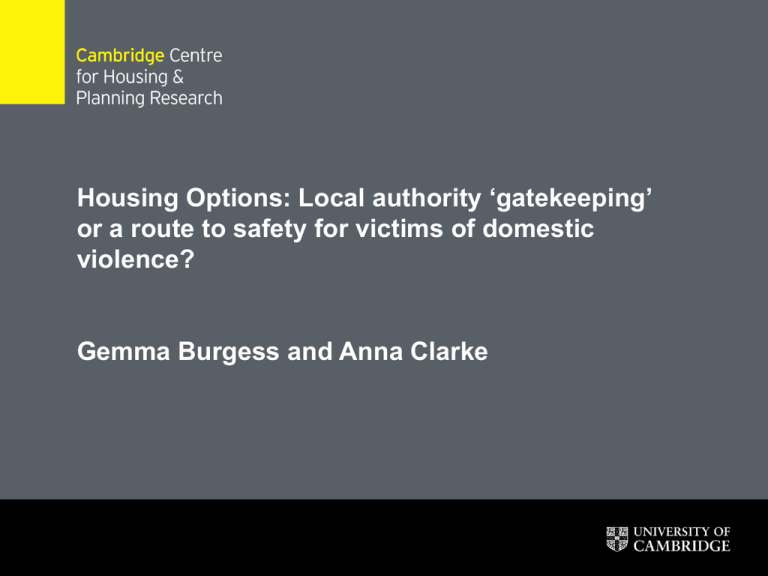Homeless victims of domestic violence
advertisement

Housing Options: Local authority ‘gatekeeping’ or a route to safety for victims of domestic violence? Gemma Burgess and Anna Clarke Context • LAs have a range of legally prescribed duties to those who are homeless or at risk of homelessness. • Housing Options have emerged in the last 10 years as a parallel means to offering assistance, with a key focus on prevention. Focus of the research • Adults without dependent children (“single adults” hereafter) who have to leave their home because of domestic violence. and • Who seek help with housing from a local authority in England. Domestic violence • Domestic violence = “any incident of threatening behaviour, violence or abuse (psychological, physical, sexual, financial or emotional) between adults who are or have been intimate partners or family members, regardless of gender or sexuality” • Evidence suggests it does affect both genders, but women more commonly than men, especially when involving repeat victimisation or physical injury. • Victims commonly find it hard to leave a perpetrator. • A lack of safe, affordable independent accommodation is known to be one major reason for failing to leave. Homelessness legislation - local authorities determine: • Are they homeless? – Local authorities must give proper consideration to applicants for housing assistance if they have reason to believe they are homeless or threatened with homelessness (within 28 days) • Are the eligible for assistance? – Eg. not if they are from outside EU and no recourse to public funds. • Are they in priority need? – Families with children – Pregnant women – Other people who are vulnerable as a result of old age, mental illness or handicap or physical disability or other special reason • Are they intentionally homeless – Did they do something or fail to do something which would have prevented them becoming homeless? If yes to all of this: • Full duty is owed. This involves: – securing temporary accommodation until settled accommodation can be found. – Offering a secure tenancy (i.e. a social rented tenancy) unless the applicant voluntarily accepts one in the PRS. If no: • Advice and assistance need to be offered: – may include referral to temporary accommodation in the voluntary sector. – may include other advice and assistance in accessing settled housing via the waiting list or in the PRS. Homeless victims of domestic violence • Would generally be owed a full duty if they have children or are pregnant. • If not, the decision hinges on whether they are considered vulnerable. • 2002 Act specifies that a person can be vulnerable: “as a result of ceasing to occupy accommodation because of violence from another person or threats of violence from another person which are likely to be carried out”. Methods • • • • Web-based survey of all LAs (128 replied). Stakeholder interviews. Analysis of CORE, P1E and SP data. Survey of Women’s Aid refuges (data on 392 single women). • Case study work in 4 LAs (1 London, 1 SE urban, 1 Midlands city, 1 Northern largely rural). Research findings: LA survey • Around a quarter of local authorities consider people fleeing domestic violence to be vulnerable in all or virtually all cases. • The remaining three quarters consider cases on an individual basis and make an assessment of whether the domestic violence has made the applicant “vulnerable” in some way – i.e. less able to fend for themselves if homeless. Assessing vulnerability • LAs who assess vulnerability on a case by case basis generally find it a difficult judgement to make in the context of domestic violence: “It is not an easy test. It is unscientific. It boils down to the approach of the local authority and your approach as an individual. It is a judgement, not a matter of the degree of training you have had. The same circumstances of an individual in one local authority may be classed as vulnerable in one local authority and not in another... [Despite the case law]…..it is still clear as mud”. (Local authority, northern case study) • Other agencies (including agencies specialising in domestic violence support, police and women’s refuges) generally had a poor understanding of the vulnerability legislation. • Refuges and other agencies were concerned that proving vulnerability could be a stressful process for their clients (e.g. needing to provide doctor’s notes on their mental health, etc). Housing Options • Greater focus on prevention of homelessness than previously. • Greater use of PRS (rent deposit schemes, etc). • Have made considerable impact on numbers of homelessness presentations (Pawson 2007). • Unclear to what extent homelessness is prevented or homeless applications are prevented. How does Housing Options work sit alongside the formal homelessness application process? • As a forerunner – Housing Options work carried out to prevent homelessness where possible; formal assessment if it fails. • Alongside - Housing Options work carried out at the same time as a formal assessment. Solution often found before assessment is concluded. • After assessment – All assessed on first contact and Housing Options work focussed on those who are not owed a full duty, or LA has no reason to believe may be homeless or threatened with homelessness. Does the use of Housing Options services improve outcomes for victims of domestic violence? Sometimes a positive impact: • Assistance for all, irrespective of whether owed full duty. • Removing need for assessment and related stress and uncertainty for clients. • Speeding up access to temporary accommodation. • More appropriate temporary accommodation (general purpose hostels often used for statutory homeless were the most commonly reported forms of inappropriate housing for this client group). • Greater choice of accommodation, especially if applicants are interested in the PRS. Sometimes no impact – Previously, a homeless application taken and referral to women’s refuge whilst enquiries made, then social rented tenancy offered (Homeless acceptances 1; homeless preventions 0). – Under Housing Options, no application taken, referral to women’s refuge whilst given additional priority on waiting list, then social rented tenancy offered (Homeless acceptances 0; Homeless preventions 1). – Different process, same outcome for client. Sometimes a negative impact – Housing Options could feasibly be used as a means of ‘gatekeeping’ as applicants prevented from making homeless applications until they have exhausted Housing Options services. – Reduced access to some forms of temporary accommodation and to social rented housing in the long term. – Reduced certainty that accommodation will be found for applicant (i.e. no safety net). What factors determine whether the impact is positive? • Homeless assessment either alongside or before Housing Options work – ie Housing Options not a barrier to making application • On-going case work under Housing Options to ensure applicants actually find accommodation and that they go there – e.g. accompanying them, phoning for them, etc. • Outcomes of Housing Options monitored and known to the local authority. • Sufficient supply of appropriate temporary and long term accommodation • Final tenure? Social renting more secure and affordable but PRS more anonymous. No evidence found to suggest victims of domestic violence any safer in social housing, though in high priced areas they do prefer it. Moving forward • New legislation will allow LAs to discharge their duties to homeless applicants by offering a tenancy in the PRS. • What possible impact will this have on people made homeless by domestic violence? – Less incentive for clients to be accepted as homeless? – LAs happier to accept homeless applications because it will be easier to discharge their duties to them? – Those deemed vulnerable more likely to enter PRS? • If Councils spend less of their grant funding on domestic violence projects this may affect provision of suitable supported housing such as refuges








